- Author Matthew Elmers [email protected].
- Public 2023-12-16 21:49.
- Last modified 2025-01-24 09:17.
- Bambarbia! Kirgudu!
- What did he say?
“He says that if you refuse, they will… stab you. Joke.
- Joke!
("Prisoner of the Caucasus, or Shurik's New Adventures")
The appearance on the screen of the unforgettable trinity (scene in the restaurant) always causes laughter because of how skillfully Coward, Experienced and Goonies shared the national Caucasian costume that they inherited, including the dagger. Well, yes, after all, what a mountaineer is without a dagger, but here he hangs right on the belly and … you can no longer see anything behind him. Meanwhile, this is an interesting example for military psychology: clothing is enemy, the war with the enemy goes on from 1817 to 1864, and, nevertheless, both the clothing and weapons of this enemy are becoming so popular that they are worn by officers of the regular Russian army and the Cossacks. … The very name of outerwear - Circassian - indicates its specific origin and … nothing!
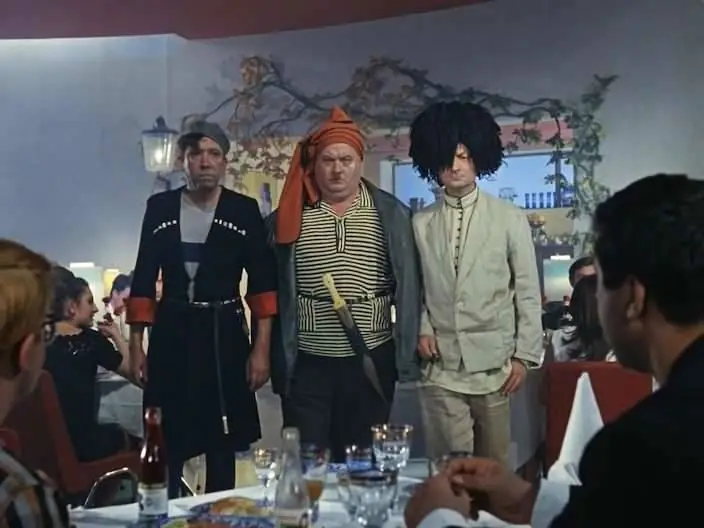
Here she is - Kama, on the belt of the Experienced …
True, here we can say that there were mountaineers loyal to the White Tsar, and that His Majesty's Imperial convoy at the time, almost all consisted of the mountaineers of the Caucasus and was dressed in their national uniform! It is obvious that perfection is to blame in many ways. The perfection of clothing, the perfection of checkers (from the Adyghe / Circassian "seshue" or "sashkho" - "big" or "long knife"), the perfection of the dagger - kama, which was included in the set of weapons of the mountain warriors - that was what made all this use their opponents. Although, the beauty of this weapon also played a significant role.

Dagger 1845 France. The beauty of the scabbard finish and the expertly crafted hilt are certainly impressive. But how to hold such a dagger in your hands? Los Angeles County Museum of Art.
This is where we come to the eternal theme: beauty and purposefulness. "And a dung basket is a beautiful thing," Socrates said, "and a golden shield can be ugly if the first one is made perfectly for its purpose, and the second is bad!" That is, it is obvious that there are more harmonious samples of weapons, including with regard to decorations, than others. In some, decoration prevails and then it is no longer a weapon or almost not a weapon, in others the crude utilitarianism of a kitchen knife or the equally vulgar “beauty” of a prison “finca” dominates, but still others are exactly what we denote by the concept of harmony … In such a weapon, practical feasibility and artistic design merge together, and in the end we have the aesthetic perfection of the product. And here, perhaps, there is simply no better specimen than the Caucasian Kama!

Indian "butt" dagger zafar taki XVIII - XIX centuries. Length with scabbard 57.5 cm; without scabbard 47.6 cm; blade width 3.3 cm; weight 348.7 g; scabbard weight 201.3 g. Metropolitan Museum of Art, New York. In the collection of the museum since 1935. As you can see, the Hindus also knew how to produce straight blades, actively used and skillfully decorated such daggers. Metropolitan Museum of Art, New York.
Here we again turn to theory, and she says that the eternal confrontation between the West and the East gave rise to two types of blades: piercing straight (weapons of the West) and cutting "curves" (weapons of the East). The Romans - who used the tactics of disciplined legions and understood earlier than others that stabbing is better than chopping - no need to swing! That is why, for example, in the British cavalry in 1908, the thrusting sword was again introduced, which was widely used in the First World War. However, the curved blade is not a hindrance to the rider, as it inflicts very deep cut wounds. Another thing is that it should not be very curved, so as not to lose its piercing functions. Examples are the Japanese katana and, again, "our" checker, with which you can chop and stab!

Dagger of the Landsknechts of the 16th century Louvre. Paris. It seems that the blade is very functional, designed to pierce chain mail. But just imagine how his handle lies in your hand, and how you act with it? Although the scabbard, yes, the scabbard is very beautiful.
As for the dagger, it has been proven that the blow from top to bottom is the strongest. The curved blade in this regard loses the stronger, the more curved it is!
And here, again, it was the Caucasian highlanders who decided the issue of choosing the best weapon, armed with a curved saber and a straight dagger. The first is best to cut at a gallop, the second is to stab the enemy in hand-to-hand combat, although the long and durable blade allows you to deliver kama and chopping blows. That is, it is truly a universal weapon!

A typical kama dagger of the early 19th century. Steel, gold, silver, niello. Length with scabbard 53.3 cm; length without scabbard 50.6 cm; blade length 38.1 cm; blade width 3.3 cm; weight 382.7 g; scabbard weight 240.9 g. Metropolitan Museum of Art, New York.
And now a little about the role of kama in the history of Russian … literature. After all, it was precisely the kama that hung on the belt of the Circassian coat of N. S. Martynova, and thanks to her, Lieutenant M. Yu. Lermontov nicknamed him "a savage with a large dagger" or "a mountaineer with a large dagger" or simply "Mr. Dagger". Mr. Martynov's "defenders" usually say that Lermontov, they say, "himself ran into" a duel with his endless mockery. He scoffed, scoffed, and bored a man. However, Martynov was by no means without sin - he had grown huge sideburns for himself, and he used to appear in a Circassian costume with an exorbitant dagger, in a white puffed-up hat, with a gloomy and silent air.

Kama XVIII - XIX centuries Become, horn, wood, leather, silver. Length with scabbard 51 cm; length without scabbard 49.1 cm; blade length 35.6 cm; blade width 3.8 cm; weight 328.9 g; scabbard weight 87.9 g. Metropolitan Museum of Art, New York. In the collection of the museum since 1935.
In fairness, it should be said that Martynov usually wore the uniform of the Grebensky Cossack regiment. But at the time of the unfortunate quarrel in the Verzilins' house, he was retired and therefore "made various free additions to it." So, he was dressed in a white Circassian coat and a black velvet or silk beshmet, or, on the contrary, wore a black Circassian coat and a white beshmet. In rainy weather, he covered his head with a black hat instead of a white one. He rolled up his Circassian sleeves, which gave "his whole figure a bold and defiant look."
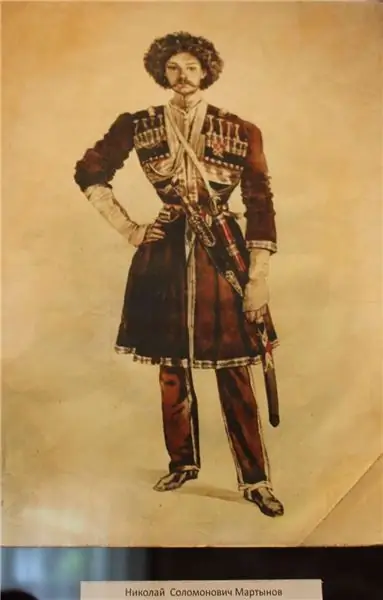
Here he is, "Monsieur Dagger" - Mr. NS Martynov.
That is, he behaved like … a modern and not very smart demobilization, well, and then they talked about such fats! Martynov, of course, understood that he was handsome, tall, looked impressive, but like any stupid person he was inclined to posturing. Here Lermontov's hand itself reached for a pencil in order to capture such a colorful figure …
For example, a drawing by M. Yu. Lermontov: Martynov is entering Pyatigorsk. Around the ladies, amazed by his beauty, and the ladies, "and the hero entering … were remarkably similar." Under the picture there is a caption: "Mr. Dagger enters Pyatigorsk."
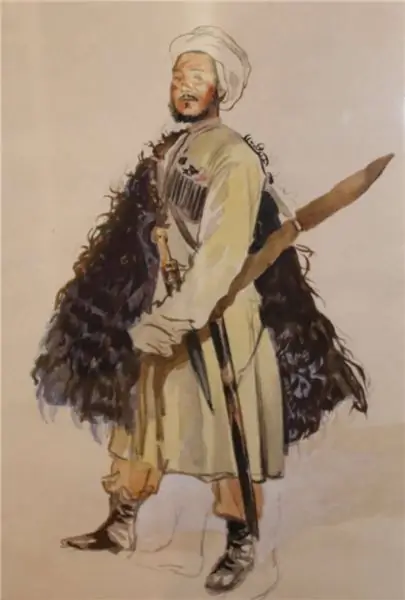
"Highlander" is a watercolor of Lermontov's times.
There is also another drawing. On it Martynov with a huge dagger, literally from waist to ground, is talking with a miniature Nadya Verzilina, who also has a kind of small "lady's" dagger hanging on her belt.
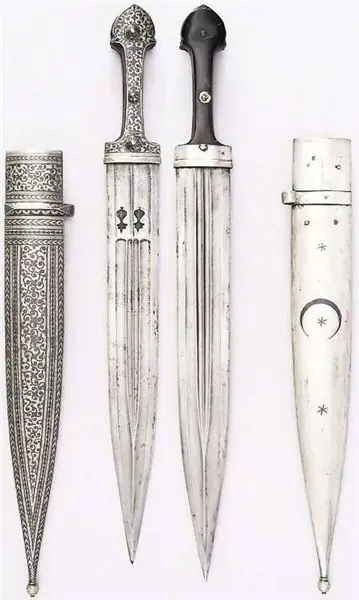
Kama in a silver scabbard of the 19th century. Steel, horn, silver, black. Length 55.4 cm; length without scabbard 51.4 cm; blade length 37.8 cm; blade width 5.4 cm; weight 445.1 g; the weight of the scabbard is 394.1 g. An interesting feature of the blade profiling: the heel has two wide lobes, and then four narrow ones (front side). On the back side, two wide and two narrow lobes reach the narrowing of the blade. Metropolitan Museum of Art, New York. In the collection of the museum since 1935.
It is possible that if Martynov had not had this ill-fated dagger ("it is not clear who is attached to whom: Martynov to the dagger or the dagger to Martynov!") The fatal duel would never have happened, and the poet Lermontov worked for many years in the field of Russian poetry and prose, but … it was precisely the “big dagger” that stood between them, and this dagger turned out to be, by the irony of fate, a mountain kama perfect in all respects!

Here, in this living room in the Verzilins' house in Pyatigorsk, the fate of the great poet was decided.

Unique kama with a wavy blade of the 19th century. Steel, silver, enamel. Length with scabbard 54.9 cm; length without scabbard 52.1 cm; blade length 39.4 cm; blade width 3.4 cm; weight 436.6 g; scabbard weight 354.4 g. Metropolitan Museum of Art, New York. In the collection of the museum since 1935.
As for the history of the kama itself, the name of this dagger comes from the Abkhazian aҟam; and the Kabardino-Circassian k'ame, that is, it came to us from the Abkhaz-Adyghe languages. The blade is traditionally long from 30 to 50 cm, straight and double-edged. There can be a fuller on the blade, and the fullers can be asymmetrically located relative to each other, which, of course, increases its rigidity. The section of the blade is lenticular or rhombic. The narrowing of the blade to the point is smooth. The handle is narrow, has no crosshair, the pommel is massive. A scabbard is attached to the dagger, which is usually worn on a belt with a set.

As you can see, there are no rules without exceptions. Here is a kama, but with a curved blade and without valleys, XIX centuries. Steel, leather, wood, silver. Length with scabbard 45.2 cm; length without scabbard 43.8 cm; blade length 31.8 cm; blade width 4.3 cm; weight 280.7 g; scabbard weight 79.4 g. Metropolitan Museum of Art, New York. In the collection of the museum since 1935.
Depending on the region, the kama has its own, so to speak, national characteristics. So the Azerbaijani blade has its ornamentation of the blade as its distinctive feature. At the same time, both floral and geometric patterns can be used in the ornament, as well as characteristic Muslim ornaments - arches, curly branches with stylized leaves rarely located on them. A slotted ornament is also used.
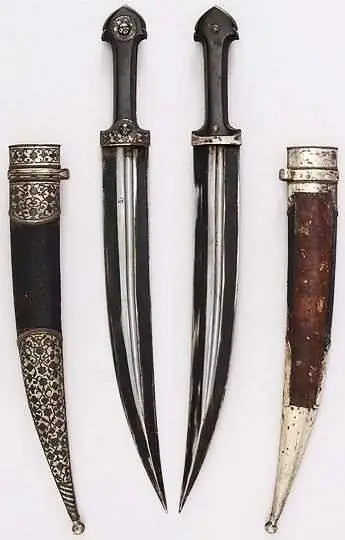
Bebut style kama with a blued blade of the 18th - 19th centuries. Steel, horn, wood, brass, silver, textiles. Length with scabbard 27.8 cm; length without scabbard 27.1 cm; blade width 2.9 cm; blade weight 268 g; scabbard weight 31.2 g. Metropolitan Museum of Art, New York. In the collection of the museum since 1935.
The Armenian-made kama has an elongated head, which gives it the shape of a typical eastern arch. Popular is the decoration with festoons in the form of tulips, which are placed both on the handle and on the scabbard. Gold and silver notches are often used at the same time.

Georgian kama decorated with corals of the 19th century Steel, silver, coral, gold. Length 61.3 cm; length without scabbard 58.6 cm; blade width 5.7 cm; weight 516 g; scabbard weight 249.5 g. Metropolitan Museum of Art, New York. In the collection of the museum since 1935.
The Georgian kama has a short and wide blade, besides, on the handle there are hats with edges carved in the form of flower petals. The blades of Georgian daggers are usually decorated in the middle part with overhead welding plates, and at their heels there may be figured through cuts, edged with gold or silver notching. The silver trim of the handles and scabbards is made with a solid floral or floral ornament in the technology of blackening with engraving, as well as with gilding. Dagestan daggers have a very elongated head of the handle. In this they are similar to Armenian daggers. But the daggers of masters from Dagestan at all times were considered, and are still considered the best in the Caucasus. They are also called "Kubachin" by the name of the village where they are produced.

Kubachinskaya Kama, Dagestan, XVIII - XIX centuries Steel, wood, silver, niello. Length 56 cm. Metropolitan Museum of Art, New York.
The first thing that catches your eye when you consider such a dagger is the excellent ratio of the length of the blade itself to the width and also to the size of the handle - not too large and not too small. In addition, their blades are usually made according to the Lezgin pattern - with the valleys shifted relative to each other. This design provides the greatest rigidity to the blade and makes it the lightest. In valleys, a pattern is often etched that copies the pattern that occurs with welding steel.
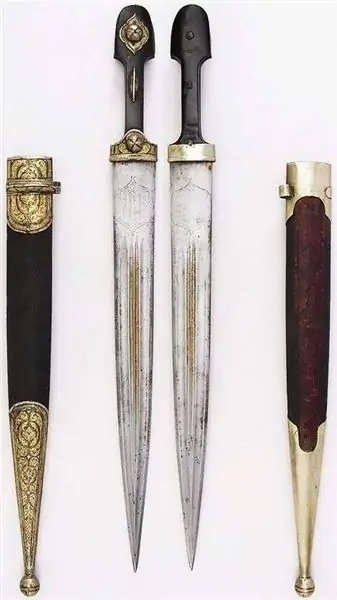
Service kama XVIII - XIX centuries Steel, horn, wood, leather, silver. Length 51 cm; length without scabbard 49.1 cm; blade length 35.6 cm; width 3.8 cm; weight 328.9 g; scabbard weight 87.9 g. Metropolitan Museum of Art, New York. In the collection of the museum since 1935.
The space between the lobes and the blades is usually blued with wide dark stripes, which gives the blade a completely unusual look. The heads of the handles are also elongated, or they repeat the shape of the head of the so-called official model, adopted in Russian Cossack units, especially in the authorized ones - daggers of machine-gun teams and artillerymen's bebuts. The decoration technique is similar to the traditional Kubachi technique of decorating any metal product.
The Lezgin dagger is a kind of Dagestan dagger, but the Khevsurian dagger is similar to the Georgian dagger, but the details of the handle and scabbard are made of brass or iron, and are decorated with the simplest ornament, which is made with a copper notch.

Dagger of the 18th century. Cleveland Museum of Art.
So perfection is perfection, beauty is beauty, namely kama turned out to be that straw that, as they say in the East, broke the back of a camel. That is, it played a fatal role in the fate of Lermontov and Martynov …






